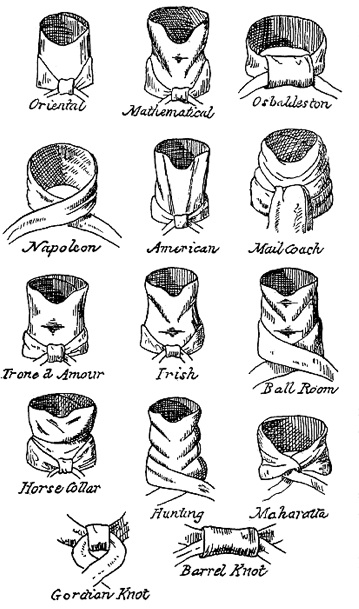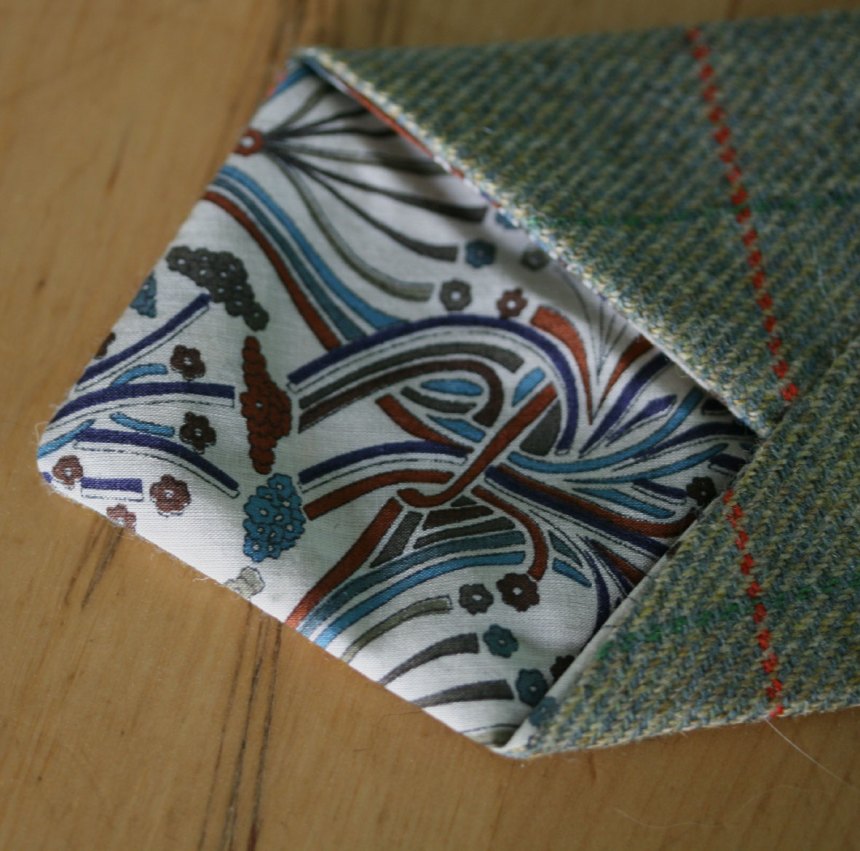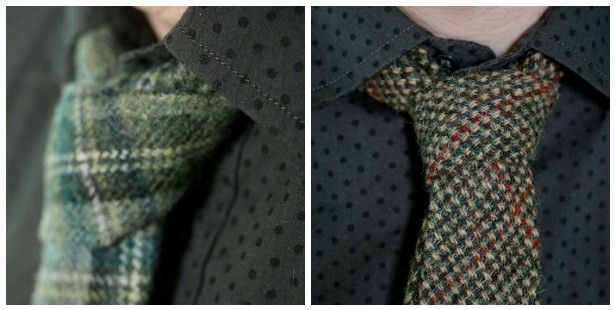
from Neckclothitania, (1818)
Most of my evenings this week have been given over to cutting, folding, and carefully stitching neckties. Young or old, smart or casual, all the blokes in my family this year will be receiving a handmade tie. I can share this information with you because with one exception (my Dad) these blokes do not read this blog, and Ma has promised to keep Dad from having a sneaky peek.
There is more to making a tie than you may imagine. If you look at the construction of a well-made one, you’ll see what I mean. They are usually formed of three pieced sections, all cut on the bias to allow the fabric to lie and hang correctly. Ties are rolled and folded in quite a specific and complicated way, and their back seams are invisibly closed with an even slip stitch. I’ve not done much research on the history of the necktie, but from what I can find out, the basic shape of what we now know as the modern tie originated with a late-nineteenth century British haberdasher named Tremlett; three piece bias-cutting was the 1926 innovation of a New-York tailor called Jesse Langsdorf; and Richard Atkinson of Belfast introduced the even slip-stitch in the late 1920s.

You can find a few online tutorials for making ties (for example, here and here). There are also paper patterns available, but I used the instructions in the 1938 edition of the Odham’s Pictorial Guide to Modern Home Needlecraft as my starting point. (I absolutely love this book — it includes straightforward instructions for all sorts of pattern cutting, tailoring, and garment construction. Everything you need is there!) Because my ties are made out of narrow lengths of tweedy fabric, I had to cut and piece them in two sections rather than just cutting one long 36″ length suggested here.

I worked out the angles with a protractor, drew the design on paper, then cut out lengths of tweed and liberty tana lawn for the lining (two very different but equally pleasing types of fabric. Wot a treat!) I then lined both tie-tips, machine-sewed a narrow seam on each long side, and then folded the tie into shape. This bit required lots of steam and pressing action; the use of an old tie as a guide; and a degree of care and concentration. In fact, I think my one piece of advice when tie-making is to spend a lot of time over this folding and pressing part. It really pays off. So after pressing the folds ruler-straight, I pinned them, and, over a few evenings, hand-stitched all my ties closed using the even slip-stitch method (it really is invisible!).

The tweed is substantial enough not to need interlining, and, after pressing, these ties look pretty good, (even though I do say so myself). Because a couple of them are made with very narrow waste lengths of tweed picked up at Hinnigan, I was unable to cut them completely on the bias. But the hang of the fabric still seems OK, and they passed the Tom test anyway, which can be quite exacting.

In this instance, the shirt and the ties aren’t a particularly good match, but the model had Christmas brewing to do, and was not keen on changing his clothes several times on the grounds of tasteful colour coordination. . .

. . .but you get the idea anyway.
So, ’tis the season to wear a festive tweedy tie. Yes it is. Listen up, O ye assorted brothers-in-law. . .

I once made 14 silk satin ties in lavender for a musical production, and I must say that your lovely tweedy ties look far better than my paltry efforts!
LikeLike
I now have a copy of the Pictorial Guide winding it’s way from a used bookshop in Ireland – I was floored by the idea of a handmade tie, entranced. It is just such a gorgeous idea, I have to find someone who wears ties….
LikeLike
Bravo on the ties. They are very handsome. this is a present my hubby would love. He is somewhat of a dandy.
LikeLike
I love the fabric!!! Those look so much cozier than the silk ties forever for sale. I think my husband will get one soon…
LikeLike
For some reason, I am completely astounded by the idea of hand-making ties. Ha, I guess the fact that I’m not a seamstress kind of shows sometimes!
LikeLike
Oh. my. gosh. These are great!! Love that tweed!
LikeLike
I am very much enjoying your Ties.
I once made a Tie for my job as Impressario of The Cabaret Society’s staging of The Rocky Horror Picture Show. I coupled it with a fetching moustache and a tails coat.
My Tie, however, was not assembled with the same attention to detail and constructional precision embodied by your Ties; there was a most unsightly seam across the middle front of mine, and I can attest that sewing a large sparkly gem over this did nothing to improve its appearance.
I can also report that you are absolutely right about the necessity for good, hard ironing during the arrangement of the tie pieces prior to sewing.
Your Ties are things of great beauty and I love your choices in fabric.
One of my very favourite pieces of art involves Ties. In Cultural Ties, Jeffrey Vallance mailed heads of state all over the world with an enclosed Tie of his own and a letter requesting that they exchange ties with him as a symbol of deepening International relations.
He then exhibited the ties that he got sent and the letters accompanying them… encountering this work gives very good insights into the world of professional men and their dress.
LikeLike
I am seriously impressed! I am happy to knit socks for my men but I would never have thought of making a tie! Superb fabric combinations!
LikeLike
Oh my, what a lot of work. Did you ever read the Pamela Aidan trilogy about Mr. Darcy? There’s a great bit in there about Darcy’s ties. And it’s DARCY.
LikeLike
those are lovely!! that is the same stitch I use to sew down quilt bindings. :)
LikeLike
i love the bias plaid, it looks like you caught a plaid on the move. the other tweed is also gorgeous. and thanks for the odham’s reccies, very interesting i find them.
i wonder if some day you will connect the dryad/odhams/artisanal life with the english class system, the labour movement and/or marxism? we americans get your class thing so wrong i fear to tread in it.
LikeLike
What a great idea! The boyfriend’s always whining that he can’t find plain ties, and leaving nice ones in German hotels. I forsee several ties for birthdays…
LikeLike
wow. what a great idea! the combo of tweed and liberty print is awesome. must get my hans on a copy of that book.
LikeLike